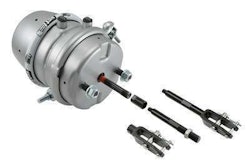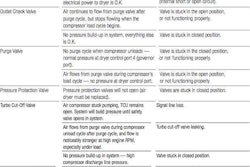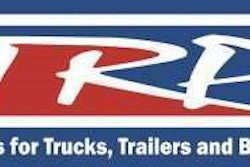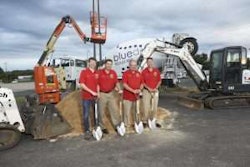
[This article was originally published in 2017 by Trucks, Parts, Service. It has been updated to include more timely information.]
Bendix Commercial Vehicle Systems (Bendix) has released the following insights for inspecting and, when possible, reconditioning air brake and wheel-end components that have been submerged in flood waters.
When checking a submerged vehicle, “at the top of the list is the question of whether the floodwater was salt water,” says Randy Salvatora, engineering manager – vehicle systems. “If the answer is yes, then you should immediately begin replacing parts.
“Pneumatic air brake valves that have been submerged have likely lost necessary lubrication, for example. Couple that with the extremely corrosive nature of salt water and these valves have a higher risk for unexpected and premature malfunction. Any air valve that’s been submerged in sea water should be replaced, along with air compressors, air reservoirs, antilock brake system (ABS) relays, modulators and brake actuators,” Salvatora says.
Bendix says salt water also heightens the possibility of corrosion at the wheel ends, leading to increased chances of rustjacking and damage to other components. Again, Bendix recommends complete replacement to prevent future failure.
If a vehicle was in a coastal area, and it’s not clear whether the water submergence was by fresh water or salt water, it’s best to play things safe and follow the above guidelines. Additionally, during the replacement of any pneumatic system components that have been subjected to flood conditions, all contaminated air hoses should be disconnected, flushed with clean water, and blown out with air pressure to remove contaminants, the company says.
[RELATED: Regenerative braking: Catch up on the future of slowing down]
When it is certain that a tractor or trailer was submerged in fresh water, carefully power wash both, including the foundation brakes, to assist in determining the condition of components. Then take the following steps to properly check the air brake control systems:
Vehicle valving
- To check for evidence of water or contamination, mark and remove the connectors at the first valve in the system from the front.
- Inspect the valve for water and contaminants, and carefully use air pressure to blow air through the hoses and watch for evidence of water or contamination.
- Continue to inspect all the valves in the air brake system, removing one service and control hose from each to inspect. Replace any non-functioning valves.
- In the unapplied state, most valves have the delivery open to atmosphere at the exhaust port, so if any exhaust port is submerged, the water has infiltrated the system and can lead to future malfunction.
- Be cautious while cleaning: Irreparable damage will occur when exhaust ports are directly sprayed by a high-pressure washer. Pneumatic components are not designed for this.
The air supply sub-system
- When any water has entered the air compressor or dryer through the air system intakes, do not attempt to start the vehicle.
- Use dry compressed air from a stationary (or suitable portable unit) air compressor to drain the service tanks of any residual water. Air dryers remove moisture in compressed air, but they won’t remove moisture that’s present after the service tanks.
- After pneumatic lines are reconnected, install a new or properly serviced air dryer to aid in removing any residual moisture from the air inlet.
- Replace the purge valve assembly and desiccant cartridge regardless of the level of contamination found.
[RELATED: Combating rustjacking is an industrywide effort]
Wheel-ends
Regarding wheel-ends, Mark Holley, director, marketing and customer solutions – wheel-end, says:
- Examine wheel-ends for water, which increases the possibility of rustjacking (corrosion between lining material and the shoe table) on drum brakes, and can pool in drums when left standing, leading to corrosion.
- Ensure the integrity of the friction coupling between the friction and disc or drum.
- Verify no water has entered the chamber through the airlines by removing fittings and mounting stud nuts and orient ports down. If present, drain and reinstall. Follow the appropriate wheel-end relubrication procedures, including regreasing slack adjusters.
- Check for signs of corrosion damage, particularly in areas such as the clevis pin connection of the slack adjuster.
- Many slack adjusters (including the Bendix Versajust series) have a grease purging vent. Floodwater could infiltrate this vent, damaging the slack adjuster on the inside, undetectable through an exterior visual inspection. Submerged slack adjusters should be replaced.
- Water-filled loading docks may not immediately come to mind as “flood events,” but can certainly have the same impact to some wheel-end components such as slack adjusters.
- Inspect drum brakes’ cam tube bushings and replace as needed. Replace all cam tube seals and lubricate the cam tube assembly until fresh grease emerges from the shaft seal.
- If an air disc brake caliper has been submerged for a significant amount of time in salt water, replace it.
- Inspect air disc brake rotors: Rust on the surface of a rotor may be acceptable, but significant flaking or pitting is not.
- Inspect the functionality of air disc brake calipers by removing the brake actuator and inspecting the sealing area where the actuator pushrod enters. Look for signs of corrosion or standing water inside the caliper and replace it if they are found.
- Check air disc brake tappets by operating the lever arm with a screwdriver. They should extend and retract. If they do not move or if the lever arm is hard to move or frozen, replace the caliper. Also verify that the adjuster operates smoothly.
Electronics system and more
- All cab-mounted electronic control units (ECUs) that have been submerged must be replaced. Frame-mounted ECUs are normally weatherproof and not affected by water.
- Conduct a diagnostic download on the system using a tool such as Bendix ACom PRO Diagnostics software for both the ABS and stability (if equipped) controllers.
- In most cases, electronics will validate through self-check: If the ECU is operable, it will check the necessary solenoids, sensor, harnesses, etc.
- Inspect the seven-pin electrical connector interface between the tractor and trailer.
- Inspect tractor and trailer glad hands and the supply and control hoses because water and contaminants can pass into the air brake system through unprotected glad hands.
“Unfortunately, once water or contamination has entered into any of the air brake components — through the exhaust valves, for instance — it’s not possible to completely clear the system without total disassembly,” Salvatora says. “Given the importance of a fully functioning system and clean air, it’s necessary to replace all pneumatic air brake components if you find signs of moisture or other contamination, just as you would in the case of saltwater submersion.”
[RELATED: Misdiagnosis and manual adjustment still a problem with auto slack adjusters]
If no evidence of water or contamination is found, Bendix says to thoroughly test the air brake system and ABS before returning the vehicle or trailer to service. Also, where the ABS is concerned, the action of floodwaters and power washing may move the ABS wheel speed sensors from their normal position. By hand, push the wheel speed sensors back into contact with the exciter ring, and normal wheel bearing play will adjust the sensor position when the wheel turns.
Bendix recommends retesting — including diagnostic checks of electronic systems such as ABS, full stability (ESP/ESC), collision mitigation systems and Automatic Traction Control (ATC) — 30 days after the vehicle or trailer has been returned to service.
“We’ve got resources available 24/7 to help fleets and owner-operators with questions, including our Tech Team at 1-800-AIR-BRAKE, our Service Engineering team and our library of Service Data Sheets and Technical Bulletins on B2Bendix.com,” Salvatora says. “And keep in mind that other vehicle systems may be impacted by flooding as well, so make sure you’re following all the appropriate vehicle and system manufacturer inspection guidelines.”










